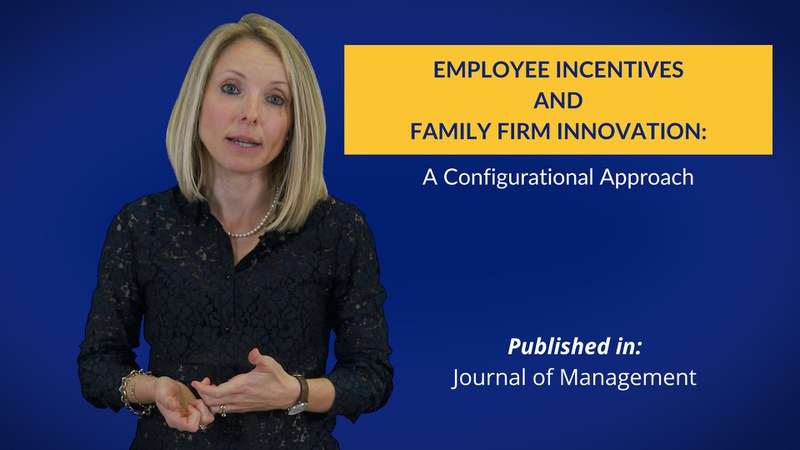Employee Incentives and Family Firm Innovation: A Configurational Approach
Published in: Journal of Management

This paper won the Prize 2023 by the EBS Universität für Wirtschaft und Recht yearly given to outstanding scientific papers with high practical relevance on Innovation, Corporate Entrepreneurship, and Transformation.
A key principle in the innovation literature is that innovation requires breaking with the past to develop new competencies and skills.
There are, however, strong theoretical reasons to believe that family firms may encounter more significant difficulties than nonfamily firms in innovating. In addition to their aversion to risk, conservative posture, organizational rigidity, and limited propensity to use investment capital to fund innovation, family firms are constrained by emotional ties and a generational shadow that complicates their willingness and ability to innovate. Because traditions and heritage are passed down through the generations, the “power of the past” often limits family firms’ experimentation, adoption of new strategies, and innovation.
However, the tendency to characterize family firms as stagnant and resistant to change is in stark contrast with the fact that over 50% of the most innovative firms in Europe are controlled by families. The idea of family firms depicted as a particular form of business organization subject to identical forces, with similar resources, missions, governance structures, and processes, has started to be jeopardized. Evidence has revealed that family firms are not all the same, and many family firms strongly attached to tradition are as innovative as those with low attachment.
The tradition–innovation paradox captures the tension family firms experience between respecting their heritage and past and the need to renew and innovate to remain competitive.
Accordingly, we assume that different behaviors can be associated with innovation, and thus, there are likely multiple pathways that support family firm innovation.
Since innovation is inherently a social process that depends on the knowledge and creativity of an organization’s people, employee incentives may be key to managing the tradition–innovation paradox and unlocking a family firm’s innovation potential. In this respect, we aim to investigate how human resource management (HRM) practices such as incentives contribute to firm innovation. By rewarding employees for their creativity and motivating them to experiment and share knowledge, incentives have the potential to guide e and stimulate employee behavior, thereby fostering innovation.
However, what types of incentives are most conducive to promoting innovation is debated, with some research emphasizing the benefits of calculative, contract-based incentives and others preferring incentives based on a collaborative, humanistic orientation.
The calculative approach relies on explicit, contract-based incentives, such as pay for performance, high salary, and specified work hours. Instead, the collaborative approach relies on implicit, relationship-based incentives that support participation in decision-making, flexibility, and work–life balance.
As both have received great support, we propose that incentives must align with a family firm’s attachment to tradition to promote innovation.
Based on the level of attachment to tradition, there may be different pathways to supporting family firm innovation. In developing an HRM perspective of family firm innovation, we propose that aligning incentives with a family firm’s level of attachment to tradition may be key to unlocking its innovation potential.
Accordingly, we aim to address the following questions:
- What incentives do innovative family firms use to motivate their employees?
- How do family firms with high versus low attachment to tradition configure incentives to promote innovation?
- What incentive configurations are most common?
Using a Qualitative Comparative Analysis (QCA) approach with a sample of 85 German manufacturing family firms, we find five different paths to family firm innovation: three for the Modernizers (i.e., firms with low attachment to tradition), and two for the Guardians (i.e., firms with a high attachment to tradition). In the five paths, we find different configurations of incentives, all conducive to a family firm’s innovation.
Considering the Modernizers, offering satisfying salaries appears critical for two out of three pathways to innovation. Salaries that produce high satisfaction should be accompanied by fixed contractual work hours or employee participation in decision-making to incentivize employees toward innovation successfully. It is worth highlighting that the vast majority of family firms with low attachment to tradition achieve innovation by compensating engagement (i.e., by combining satisfying salaries with participation in decision-making), thus demonstrating that the presence of both calculative- and collaborative-based incentives is beneficial to innovation.
Regarding the Guardians, our study reveals that family firms should focus on incentives beyond salaries and instead direct their attention toward collaborative incentives that support participation, flexibility, and work–life balance. A good balance between job-related duties and private life is necessary for incentivizing employees and achieving innovation in firms with a high attachment to tradition. Specifically, the path most commonly used by family firms with high attachment to tradition (43%) emphasizes care for people by combining support for work–life balance with employee participation in decision-making (guardians of the past and people).
Therefore, contrary to family firms with low attachment to tradition, when tradition permeates a family firm’s culture, a set of incentives fully rooted in the collaborative approach (i.e., support for work–life balance, participation in decision-making) is the most common configuration used to promote innovation.
Our study suggests that an HRM policy built on a focused and pronounced incentive strategy that complements a family firm’s attachment to tradition is most conducive to motivating employees toward innovation.
Our findings alert managers of family firms that incentive structures are a key mechanism for fostering innovation. However, which configuration of incentives is most effective depends on the firm’s attachment to tradition.
Rather than viewing incentives based on a calculative or collaborative HRM approach as “good” or “bad,” our findings suggest that a balanced approach may be more conducive to promoting innovation under some circumstances.
Read the full article
Authors at the Department of Management
ELISA VILLANI – Associate Professor
Academic disciplines: Business and Management Engineering
Teaching areas: Organizational behavior
Research fields: Innovation; Organizational behavior; Knowledge transfer; Entrepreneurship.
Elisa Villani is Associate Professor of Entrepreneurship and Innovation at the University of Bologna. Previously, she has been an Assistant Professor at the Free University of Bolzano. She has also been a Visiting Researcher at Imperial College Business School. She teaches Organizational Behavior at the master level. Her research interests lie in knowledge transfer, innovation, and entrepreneurship, focusing on organizational dynamics and processes. She has published in top journals like the Journal of Management, Journal of Management Studies, Technological Forecasting & Social Change, and Journal of Business Research.
Employee Incentives and Family Firm Innovation: A Configurational Approach
Watch the video
